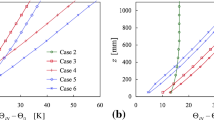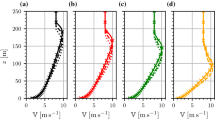Abstract
In single column and large-eddy simulation studies of the atmospheric boundary layer, surface sensible heat flux is often used as a boundary condition. In this paper, we delineate the fundamental shortcomings of such a boundary condition in the context of stable boundary layer modelling and simulation. Using an analytical approach, we are able to show that for reliable model results of the stable boundary layer accurate surface temperature prescription or prediction is needed. As such, the use of surface heat flux as a boundary condition should be avoided in stable conditions.
Similar content being viewed by others
Abbreviations
- g :
-
gravitational acceleration
- L :
-
the Obukhov length (= − Θ 0 u 3* /κg〈wθ〉)
- U :
-
wind speed at height z
- u, v, w:
-
velocity fluctuations (around the average) in x, y and z directions
- u*:
-
friction velocity \(\left( { = \sqrt[4]{{\left\langle {uw} \right\rangle ^2 + \left\langle {vw} \right\rangle ^2 }}} \right)\)
- 〈uw〉, 〈vw〉:
-
vertical turbulent surface momentum fluxes
- 〈wθ〉:
-
vertical surface sensible heat flux
- z :
-
height above the surface
- z 0 :
-
surface roughness length for momentum
- z 0H :
-
surface roughness length for heat
- ΔΘ :
-
potential temperature difference between first model grid-level and surface (=Θ-Θ s)
- κ :
-
von Karman’s constant (= 0.40)
- Ψ M , Ψ H :
-
velocity and potential temperature profile functions
- θ :
-
temperature fluctuations (around the average)
- Θ :
-
mean potential temperature at height z
- Θ 0 :
-
reference potential temperature
- Θ s :
-
surface potential temperature
- Θ * :
-
potential temperature scale (= − 〈 wθ〉 / u *)
- ζ:
-
stability parameter (= z/L)
References
Arya, S.P. (2001), Introduction to Micrometeorology, San Diego, Academic Press, 420 p.
Basu, S., F. Porté-Agel, E. Foufoula-Georgiou, J.-F. Vinuesa, and M. Pahlow (2006), Revisiting the local scaling hypothesis in stably stratified atmospheric boundary-layer turbulence: An integration of field and laboratory measurements with large-eddy simulations, Bound.-Layer Meteor. 119, 473–500.
Beare, R., M. MacVean, A.A.M. Holtslag, J. Cuxart, I. Esau, J.-C. Golaz, M. Jiménez, M. Khairoutdinov, B. Kosovic, D. Lewellen, T. Lund, J. Lundquist, A. McCabe, A. Moene, Y. Noh, S. Raasch, and P. Sullivan (2006), An intercomparison of largeeddy simulations of the stable boundary layer, Bound.-Layer Meteor. 118, 247–272.
Beljaars, A., and P. Viterbo (1998), The role of the boundary layer in a numerical weather prediction model. In: A.A. M. Holtslag and P.G. Duynkerke (eds.), Clear and Cloudy Boundary Layers, Amsterdam, Royal Netherlands Academy of Arts and Sciences, 297–304.
Brown, A.R., S.H. Derbyshire, and P.J. Mason (1994), Large-eddy simulation of stable atmospheric boundary layers with a revised stochastic subgrid model, Quart. J. Roy. Meteorol. Soc. 120, 1485–1512.
Businger, J.A., J.C. Wyngaard, Y. Izumi, and E.F. Bradley (1971), Flux-profile relationships in the atmospheric boundary layer, J. Atmos. Sci. 30, 788–794.
Cuxart, J., A.A.M. Holtslag, R.J. Beare, E. Bazile, A. Beljaars, A. Cheng, L. Conangla, M. Ek, F. Freedman, R. Hamdi, A. Kerstein, H. Kitagawa, G. Lenderink, D. Lewellen, J. Mailhot, T. Mauritsen, V. Perov, G. Schayes, G.J. Steeneveld, G. Svensson, P. Taylor, W. Weng, S. Wunsch, and K.-M. Xu (2006), Single-column model intercomparison for a stably stratified atmospheric boundary layer, Bound.-Layer Meteor. 118, 273–303.
DeBruin, H.A.R. (1994), Analytic solutions of the equations governing the temperature fluctuation method, Bound.-Layer Meteor. 68, 427–432.
Derbyshire, S.H. (1999), Stable boundary-layer modelling: Established approaches and beyond, Bound.-Layer Meteor. 90, 423–446.
Dyer, A.J. (1974), A review of flux-profile relations, Bound.-Layer Meteor. 1, 363–372.
Esau, I.N., and S.S. Zilitinkevich (2006), Universal dependences between turbulent and mean flow parameters in stably and neutrally stratified planetary boundary layers, Nonlin. Processes Geophys. 13, 135–144.
Holtslag, A.A.M. (2006), GEWEX atmospheric boundary layer study (GABLS) on stable boundary layers, Bound.-Layer Meteor. 118, 243–246.
Holtslag A.A.M., and H.A.R. DeBruin (1988), Applied modeling of the nighttime surface energy balance over land, J. Appl. Meteorol. 27, 689–704.
Holtslag, A.A.M., G.J. Steeneveld, and B.J.H. Van de Wiel (2007), Role of land surface temperature feedback on model performance for stable boundary layers, Bound.-Layer Meteor. 125, 361–376, DOI: 10.1007/s10546-007-9214-5.
Hunt, J.C.R., G.J. Shutts and S. Derbyshire (1996), Stably stratified flows in meteorology, Dyn. Atmos. Oceans. 23, 63–79.
Jiménez, M.A., and J. Cuxart (2005), Large-eddy simulations of the stable boundary layer using the standard Kolmogorov theory: Range of applicability, Bound.-Layer Meteor. 115, 241–261.
Kumar, V., J. Kleissl, C. Meneveau, and M.B. Parlange (2006), Large-eddy simulation of a diurnal cycle of the atmospheric boundary layer: atmospheric stability and scaling issues, Water Resour. Res. 42, W06D09, DOI:10.1029/2005WR004651.
Lenderink, G., A.P. Siebesma, S. Cheneit, S. Ihrons, C.G. Jones, P. Marquet, F. Muller, D. Olmera, J. Calvo, E. Sanchez, and P.M. M. Soares (2004), The diurnal cycle of shallow cumulus clouds over land: a single-column model intercomparison study, Quart. J. Roy. Meteorol. Soc. 130, 3339–3364.
Mahrt, L. (1998), Stratified atmospheric boundary layers and breakdown of models, Theoret. Comput. Fluid Dyn. 11, 263–279.
Malhi, Y.S. (1995), The significance of the dual solutions for heat fluxes measured by the temperature fluctuations method in stable conditions, Bound.-Layer Meteor. 74, 389–396.
Nieuwstadt, F.T.M., P.J. Mason, C.-H. Moeng, and U. Schumann (1993), Large-eddy simulation of the convective boundary layer: a comparison of four computer codes. In: F. Durst, R. Friedrich, B.E. Launder, F.W. Schmidt, U. Schumann, and J.H. Whitelaw (eds.), Turbulent Shear Flows 8, Berlin, Springer, 343–367.
Saiki, E.M., C.-H. Moeng, and P.P. Sullivan (2000), Large-eddy simulation of the stably stratified planetary boundary layer, Bound.-Layer Meteor. 95, 1–30.
Sorbjan, Z. (2006), Local structure of turbulence in stably stratified boundary layers, J. Atmos. Sci. 63, 1526–1537.
Steeneveld, G.J., B.J.H. Van de Wiel, and A.A.M. Holtslag (2006), Modeling the evolution of the atmospheric boundary layer coupled to the land surface for three contrasting nights in CASES-99, J. Atmos. Sci. 63, 920–935.
Steeneveld, G.J., T. Mauritsen, E.I.F. de Bruijn, J. Vilà-Guerau de Arellano, G. Svensson, A.A.M. Holtslag (2007), Evaluation of limited area models for the representation of the diurnal cycle and contrasting nights in CASES99, J. Appl. Meteorol. Clim. (in press).
Stull, R.B. (1988), An Introduction to Boundary Layer Meteorology, Dordrecht, Kluwer Academic Publishers, 670 p.
Sun, W.-Y., and C.-Z. Chang (1986), Diffusion model for a convective layer. Part I: numerical simulation of convective boundary layer, J. Climate App. Meteorol. 25, 1445–1453.
Svensson, G., and A.A.M. Holtslag (2006), Single column modeling of the diurnal cycle based on CASES99 data — GABLS second intercomparison project. In: 17th Symposium on Boundary Layers and Turbulence, San Diego, USA, 22–25 May, American Meteorological Society, Boston, Paper 8.1. http://ams.confex.com/ams/pdfpapers/110758.pdf.
Taylor, P.A. (1971), A note on the log-linear velocity profile in stable conditions, Quart. J. Roy. Meteorol. Soc. 97, 326–329.
van de Wiel, B.J.H., A.F. Moene, G.J. Steeneveld, O.K. Hartogensis, and A.A.M. Holtslag (2007), Predicting the collapse of turbulence in stably stratified boundary layers, Turb. Flow Comb. 79, 251–274.
Wyngaard, J.C., and O.R. Coté (1974), The evolution of a convective planetary boundary layer — a higher-order-closure model study, Bound.-Layer Meteor. 7, 289–308.
Author information
Authors and Affiliations
Corresponding author
Rights and permissions
About this article
Cite this article
Basu, S., Holtslag, A.A.M., Van De Wiel, B.J.H. et al. An inconvenient “truth” about using sensible heat flux as a surface boundary condition in models under stably stratified regimes. Acta Geophys. 56, 88–99 (2008). https://doi.org/10.2478/s11600-007-0038-y
Received:
Accepted:
Published:
Issue Date:
DOI: https://doi.org/10.2478/s11600-007-0038-y




